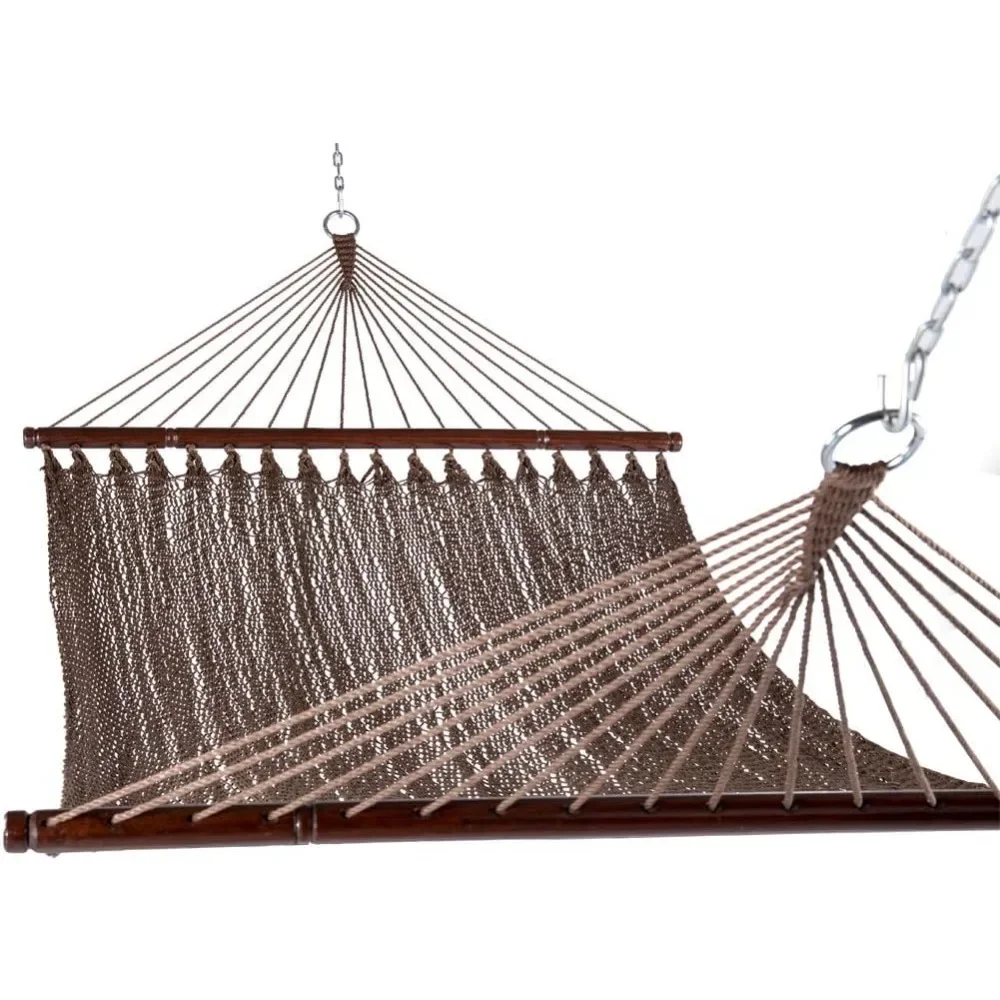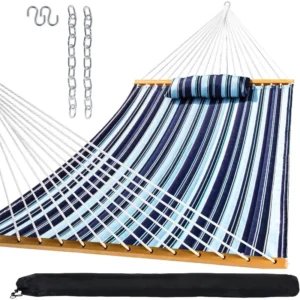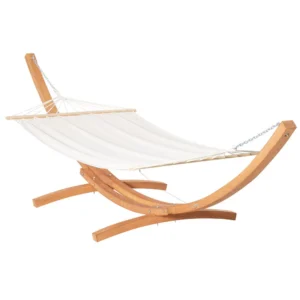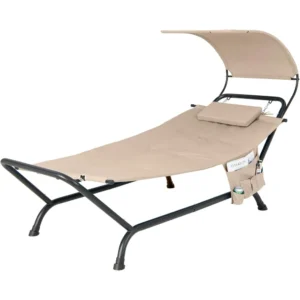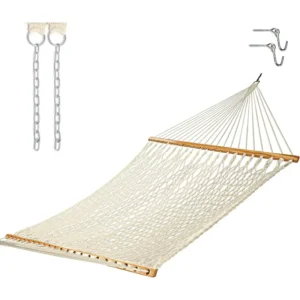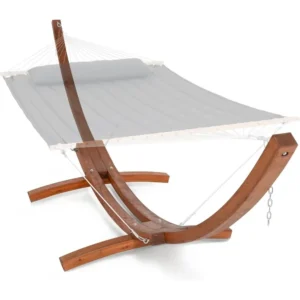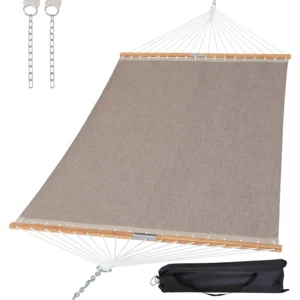The Enduring Allure of Rope Hammocks: A Heritage of Comfort
When you picture perfect relaxation, the image of a classic rope hammock often comes to mind. With their distinctive open weave patterns, sturdy spreader bars, and traditional materials, rope hammocks have earned their place as icons of leisure and comfort. These timeless pieces aren’t just outdoor furniture—they represent a centuries-old tradition of rest and relaxation.
Rope hammocks trace their origins to indigenous cultures, particularly in Central and South America, where they served as practical sleeping solutions. Over generations, they evolved from simple necessity to beloved leisure items that grace gardens, patios, and poolsides worldwide. What makes these traditional hammocks so special is their unique combination of visual appeal, exceptional comfort, and remarkable durability.
The classic rope hammock design stands out for its intricate weaving patterns that create both stunning aesthetics and functional benefits. While modern hammock options continue to emerge, the traditional rope hammock maintains its status as the gold standard for outdoor relaxation. Choosing the right location for your indoor and outdoor hammock placement can significantly enhance your relaxation experience, turning any space into a personal retreat.
In this exploration of rope hammocks, we’ll uncover the qualities that have allowed these simple yet ingenious creations to remain relevant and desirable across generations, delivering an unmatched relaxation experience that modern alternatives struggle to replicate.
Classic Design Elements That Define Rope Hammock Appeal
The enduring popularity of rope hammocks stems largely from design elements that have remained essentially unchanged for generations. Each component contributes to both the iconic look and superior functionality that make these hammocks instantly recognizable.
The Distinctive Open-Weave Pattern
The hallmark of traditional rope hammocks is their open-weave construction. Typically crafted in diamond, double latch, or other intricate patterns, these weaves aren’t just visually appealing—they serve critical functional purposes. The spaces between the ropes allow for superior air circulation, making them cooler in warm weather than solid fabric alternatives. The patterns also create a gentle texture that provides just the right amount of grip to prevent sliding while remaining comfortable against the skin.
Spreader Bars: Form Meets Function
Hardwood spreader bars at each end of the hammock create the flat, accessible surface that distinguishes rope hammocks from their gathered-end counterparts. These wooden bars, typically crafted from oak, maple, or other durable hardwoods, maintain the hammock’s width and prevent it from cocooning around you. The natural grain and warm tones of quality hardwood bars complement the rope texture, adding to the overall aesthetic appeal while providing structural stability.
Different classic rope hammock patterns and styles offer subtle variations in both appearance and comfort, with some designs emphasizing traditional craftsmanship while others incorporate modern innovations. The beauty of these hammocks lies in their ability to enhance any outdoor setting, from rustic gardens to contemporary poolsides.
The natural textures and materials of rope hammocks create visual interest through the interplay of light and shadow. As sunlight filters through the weave, it casts dappled patterns that add another dimension to the relaxation experience. This combination of rustic charm and refined craftsmanship explains why our collection of rope hammock sets continues to be among our most popular offerings year after year.
Superior Comfort: How Rope Hammock Design Enhances Relaxation
The distinctive comfort of a rope hammock isn’t just about tradition—it’s rooted in thoughtful design that works with your body to create an unmatched relaxation experience. Unlike rigid outdoor furniture, rope hammocks offer a dynamic comfort that adapts to each individual.
When you settle into a well-made rope hammock, the weave immediately responds to your body weight, creating a gentle cradle effect. This body-conforming quality distributes weight evenly across hundreds of contact points, eliminating the pressure points common in conventional seating. The result is a floating sensation that many users describe as “weightless” relaxation.
The ergonomic benefits of rope hammocks include:
- Natural spine alignment that can relieve back tension
- Even weight distribution that reduces pressure on joints
- Gentle rocking motion that stimulates relaxation responses
- Open weave design that allows cooling air circulation
- Slight flexibility that adjusts to different body types and positions
The gentle swaying motion naturally produced by hammocks triggers the same calming neurological responses that have helped humans relax since infancy. This rocking sensation has been shown to promote faster transition to sleep and can even improve sleep quality—explaining why many hammock users report dozing off effortlessly.
Unlike solid fabric hammocks that can trap heat against the body, the open structure of spreader bar hammock sets permits constant air movement. This circulation creates a naturally cooling environment, making rope hammocks particularly comfortable during warmer months when outdoor relaxation is most appealing.
The textural elements of rope against skin provide subtle tactile stimulation that many find soothing—another sensory dimension that enhances the overall relaxation experience. This combination of physical support and sensory pleasure explains why rope hammocks continue to outperform many modern alternatives when it comes to pure relaxation potential.

Unmatched Durability: Built to Weather the Seasons
One of the most compelling reasons rope hammocks have maintained their popularity through generations is their exceptional durability. A quality rope hammock isn’t just a seasonal purchase—it’s an investment in years of relaxation.
Traditional vs. Modern Materials
Traditional cotton rope hammocks offer unmatched softness and comfort but require more maintenance to preserve their integrity. Modern synthetic alternatives like polyester, DuraCord, and nylon blends deliver impressive longevity while requiring minimal care. These advanced materials resist mildew, maintain color brilliance against UV exposure, and withstand moisture without compromising comfort.
High-quality synthetic rope hammocks can last 10-20 years with proper care—significantly longer than most outdoor furniture options. This extended lifespan transforms them from a simple purchase into a genuine investment in long-term enjoyment.
Weather Resistance Properties
Premium rope hammocks demonstrate remarkable resilience against outdoor conditions:
- UV resistance prevents fading and fiber degradation in sunny locations
- Mildew resistance keeps hammocks fresh even in humid environments
- Color retention technology maintains vibrant appearance for years
- Quick-drying properties prevent water damage after rain or morning dew
The structural integrity of well-made rope hammocks comes from precise construction techniques. Properly balanced tension throughout the weave distributes weight evenly, preventing the sagging and weak spots that often develop in lower-quality alternatives.
While wondering if it’s okay to leave your hammock outside year-round, remember that materials make a significant difference. Modern synthetic rope hammocks offer substantially better weather resistance than traditional cotton, though all hammocks benefit from occasional protection from extreme conditions.
This combination of quality materials and craftsmanship creates exceptional durability that translates directly to value. While the initial investment might exceed that of budget hammock options, the extended lifespan eliminates the cycle of frequent replacements—making rope hammocks both economically and environmentally sensible choices for discerning relaxation enthusiasts.
Versatility in Placement: Creating Your Perfect Relaxation Spot
The adaptability of rope hammocks to various settings and installation methods is another factor in their enduring popularity. Unlike furniture pieces that demand specific environments, rope hammocks can transform virtually any indoor or outdoor space into a relaxation haven.
Traditional tree hanging remains popular for those with suitable mature trees spaced approximately 13-15 feet apart. This natural suspension creates an authentic, organic relaxation experience that connects you with the surrounding landscape. However, rope hammocks aren’t limited to wooded areas thanks to versatile mounting options.
Dedicated hammock stands provide ideal solutions for:
- Patios, decks, and poolsides without suitable trees
- Rental properties where permanent installation isn’t permitted
- Changing the location of your hammock to follow shade or sunlight
- Seasonal relocation between indoor and outdoor settings
- Balconies and small spaces where traditional hanging isn’t possible
Modern rope hammocks complement diverse architectural and landscape styles, from rustic country gardens to sleek contemporary patios. Their natural materials and classic silhouettes add visual interest without overwhelming surrounding design elements.
For those seeking to maximize their relaxation options, exploring the best indoor and outdoor hammock locations can provide inspiration for creating multiple comfort zones throughout your property. With proper care and occasional repositioning, rope hammocks can transition between seasons, providing year-round enjoyment in various parts of your home and yard.
For couples and families, double two-person hammock sets offer expanded relaxation space while maintaining the classic rope hammock experience. These wider designs accommodate shared lounging without sacrificing the traditional aesthetics that make rope hammocks so visually appealing.
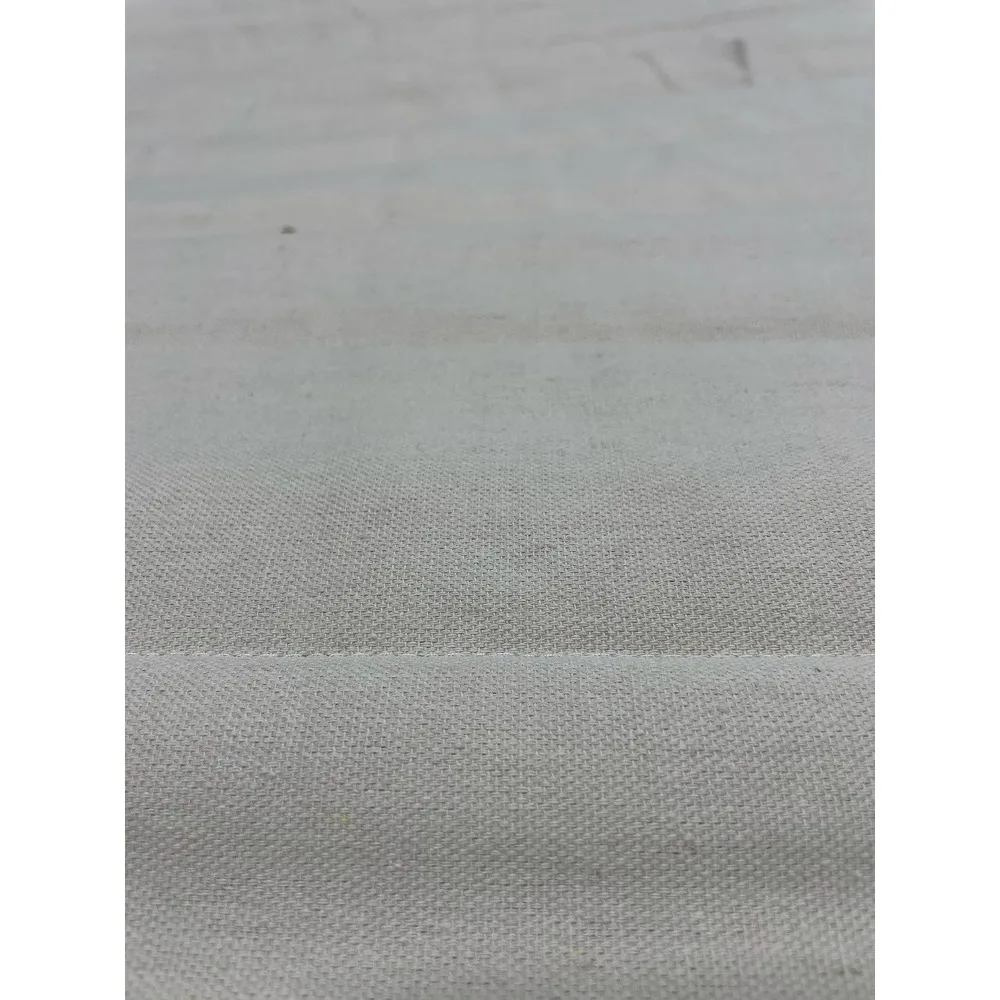
The Sensory Experience: Why Rope Hammocks Engage All Senses
The unique appeal of rope hammocks extends far beyond simple functionality—they deliver a rich sensory experience that engages multiple senses simultaneously. This multisensory quality creates a deeper, more immersive relaxation than typical outdoor furniture can provide.
The tactile experience begins the moment you settle into a rope hammock. Unlike the uniform surface of fabric hammocks, rope creates a gentle textural pattern against the skin. This subtle tactile variation provides pleasant sensory feedback without overwhelming comfort. The rope yields and adjusts with your movements, creating a responsive surface that feels both supportive and accommodating.
Visually, rope hammocks offer captivating interplays of light and shadow. Sunlight filtering through the open weave creates shifting patterns that dance across your body and the ground below. This dappled light effect adds visual interest even when the hammock is unoccupied, making it an aesthetic element in your outdoor space rather than just functional furniture.
The auditory experience includes subtle, soothing sounds that solid hammocks can’t provide. The gentle creaking of hardwood spreader bars, the soft whisper of rope fibers adjusting under your weight, and the light percussion of hardware components create a quiet symphony that enhances relaxation. These sounds connect users to the physical nature of the hammock, reinforcing its authentic, handcrafted quality.
Natural fiber rope hammocks develop distinctive, pleasant scents over time as the materials age and weather. This subtle aromatic dimension adds another layer to the sensory experience, particularly with cotton rope options that absorb environmental fragrances from nearby gardens or landscapes.
Perhaps most significantly, rope hammocks provide a kinesthetic experience defined by gentle motion. The slight giving and shifting of the rope weave creates micro-movements that promote relaxation, while the hammock’s natural swing soothes both mind and body. Understanding the differences between deep hammocks vs. standard hammocks can help you select the option that provides your ideal balance of envelopment and accessibility.
Together, these sensory elements create a uniquely immersive relaxation experience that explains why many hammock enthusiasts remain loyal to traditional rope designs despite numerous modern alternatives.
Heritage and Craftsmanship: The Artisanal Roots of Rope Hammock Tradition
The story of rope hammocks connects us to centuries of handcraft tradition that spans continents and cultures. Long before becoming symbols of leisure, hammocks served indigenous peoples of Central and South America as practical sleeping solutions. These early designs, crafted from plant fibers and suspended between trees, provided safety from ground-dwelling insects and animals while offering comfortable rest.
Traditional rope-making techniques have been passed down through generations, with specialized methods developed for creating the strong, comfortable cordage needed for safe, durable hammocks. In many regions, specific weaving patterns became cultural signatures, with families developing distinctive variations that identified their work.
The evolution to modern rope hammocks maintained core principles while incorporating new materials and construction techniques. The addition of spreader bars—a significant innovation that transformed the hammock experience—created the flat, accessible surface now associated with classic American rope hammocks. This adaptation maintained the essential hammock concept while making it more approachable for leisure use.
Regional variations showcase cultural influences:
- Latin American designs often emphasize tight, colorful weaving patterns
- Caribbean styles frequently feature wider, more open weaves for maximum ventilation
- North American traditions tend toward sturdy hardwood spreader bars and precisely balanced tension
While machine production has increased availability, many premium rope hammocks still involve significant handcrafting. The precise tension balancing, knot work, and finishing details that distinguish quality products require skilled human attention. Proper hammock installation requirements and safety guidelines help preserve these beautiful pieces while ensuring they provide the safe, comfortable experience their makers intended.
The heritage value of traditional rope hammocks adds an intangible but meaningful dimension to ownership. Using designs that have comforted and supported humans for centuries creates a connection to craftsmanship traditions that transcend modern mass production—an increasingly rare quality in today’s disposable product landscape.
Modern Innovations: How Rope Hammocks Have Evolved While Maintaining Tradition
While remaining true to their historical roots, today’s rope hammocks incorporate thoughtful innovations that enhance their performance without sacrificing traditional charm. This careful balance of heritage and advancement keeps rope hammocks relevant in contemporary outdoor living spaces.
Material science has revolutionized rope hammock durability. Advanced synthetic fibers like DuraCord and solution-dyed polyester deliver impressive weather resistance while maintaining the look and feel of traditional materials. These engineered materials resist mildew, prevent UV fading, and dry quickly after exposure to moisture—extending usable seasons and overall lifespan without changing the classic aesthetic.
Manufacturing improvements have standardized quality and precision while preserving artisanal characteristics:
- Computer-calibrated tension ensures perfect balance across the entire hammock surface
- Advanced wood treatments enhance spreader bar durability without changing appearance
- Improved hardware components increase weight capacity and stability
- Reinforced edge techniques prevent the unraveling that plagued earlier designs
Design refinements have subtly enhanced comfort without altering the recognizable silhouette. Slightly wider spreader bars provide more stable entry and exit, while optimized rope spacing prevents uncomfortable pressure points without changing the classic open-weave appearance.
For those requiring maximum durability, heavy duty hammock sets incorporate reinforced construction techniques and higher-grade materials while maintaining traditional aesthetics. These robust options accommodate larger users or more frequent use without compromising on the classic rope hammock experience.
What makes these innovations remarkable is their invisibility—the core rope hammock experience remains authentic despite significant advancements in materials and construction. This successful marriage of tradition and technology ensures rope hammocks remain practical choices for contemporary users while honoring their rich heritage.
Classic Wooden Stand Hammock Sets, Heavy Duty Hammock Sets
$1,061.68 Select options This product has multiple variants. The options may be chosen on the product pageHammock Sets with Canopy, Heavy Duty Hammock Sets
$286.31 Select options This product has multiple variants. The options may be chosen on the product pageDouble / Two Person Hammock Sets, Rope Hammock Sets
Double Traditional Cotton Rope Hammock with Extension Chains – 450 lbs Capacity for Backyard & Patio$292.98 Select options This product has multiple variants. The options may be chosen on the product pageHeavy Duty Hammock Sets, Wooden Arc Stand Hammock Sets
$878.66 Select options This product has multiple variants. The options may be chosen on the product page
Choosing the Perfect Rope Hammock: Key Considerations
Selecting the ideal rope hammock involves weighing several factors that affect comfort, durability, and overall satisfaction. Understanding these key considerations helps ensure you find the perfect match for your relaxation needs.
Material Selection
Cotton rope offers unmatched softness and traditional appeal but requires more maintenance and protection from elements. It’s ideal for covered areas or seasonal use when ultimate comfort is the priority. Synthetic options like polyester or DuraCord deliver outstanding weather resistance and reduced maintenance, making them better choices for full exposure to elements or year-round outdoor use.
Size and Capacity
Single hammocks typically measure 11-13 feet in length with bed areas around 4-4.5 feet wide, accommodating one adult comfortably. Double or family-sized options extend to 5-6 feet in width, providing space for couples or a parent with children. Weight capacities range from 275-600 pounds depending on construction quality and materials—always select a hammock rated well beyond your anticipated maximum load for safety and longevity.
Construction Quality Indicators
Quality rope hammocks reveal their superiority through several observable characteristics:
- Uniform rope tension throughout the weave pattern
- Consistent spacing between rope strands
- Tight, secure knots with proper finishing
- Smooth, splinter-free hardwood spreader bars
- Rust-resistant stainless steel or galvanized hardware
- Reinforced connection points where rope meets hardware
For those seeking elegant installation options, wooden arc stand hammock sets offer self-supporting luxury with distinctive curved supports that enhance both stability and visual appeal.
When evaluating price points, remember that higher-quality hammocks typically use more rope (creating tighter weaves), better-grade hardwoods for spreader bars, and superior hardware components. These investments in quality directly translate to comfort, safety, and longevity—making premium options more economical over their extended lifespan.
Consider accessories like weather-resistant pillows, dedicated stands, or protective covers to enhance both comfort and durability. These complementary items can significantly extend your hammock’s usable seasons while personalizing your relaxation experience.
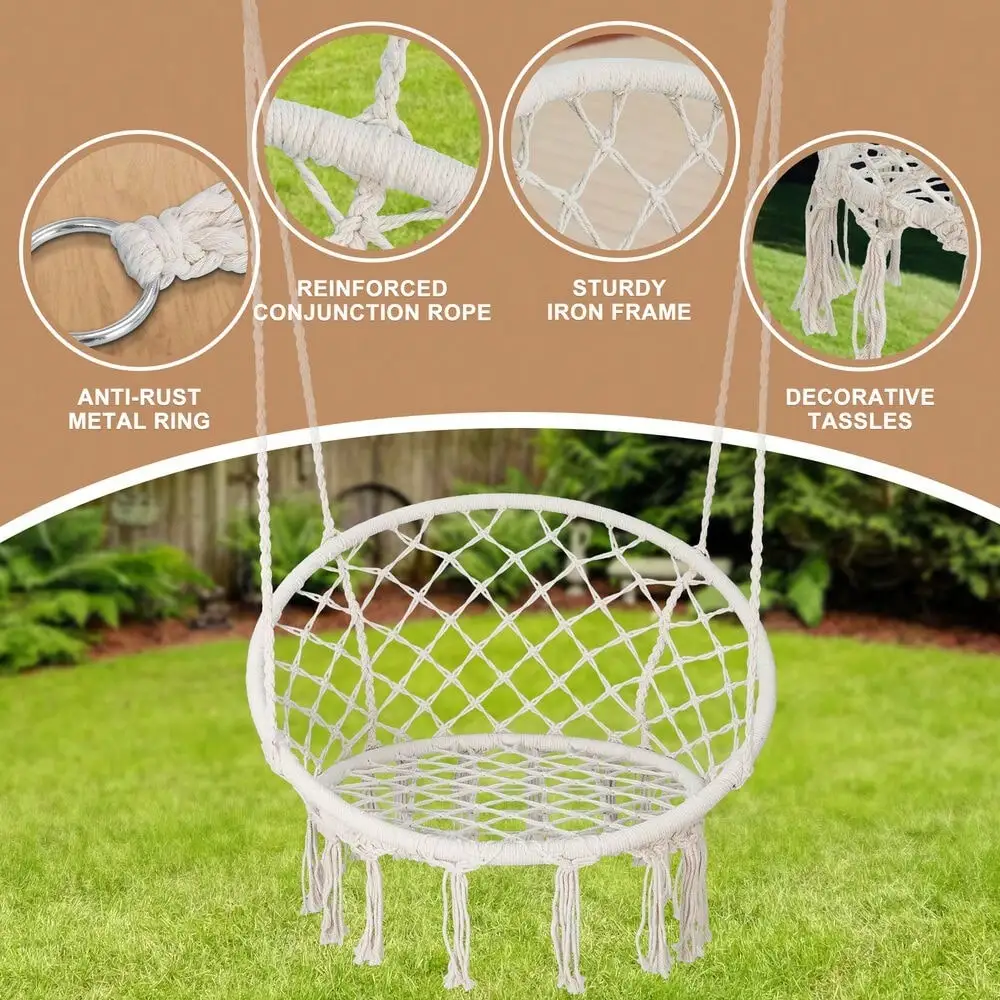
Caring for Your Rope Hammock: Ensuring Years of Enjoyment
Proper maintenance significantly extends your rope hammock’s lifespan while preserving its comfort and appearance. With minimal effort, your hammock can remain a cherished relaxation spot for many seasons.
Cleaning and Maintenance
For cotton rope hammocks, gentle hand washing with mild soap and cool water removes dirt without damaging fibers. Lay flat or hang to dry completely before storage. Synthetic rope hammocks can tolerate more vigorous cleaning—a soft brush with diluted soap solution effectively removes stubborn stains and mildew.
After cleaning any type of rope hammock, rinse thoroughly to prevent soap residue that could irritate skin or attract dirt. Always allow complete drying before use or storage to prevent mildew development.
Seasonal Storage
When not in use for extended periods, proper storage preserves your hammock’s integrity:
- Clean and dry completely before storing
- Roll loosely rather than folding to prevent permanent creases
- Store in a breathable container (cotton bag rather than plastic)
- Keep in a cool, dry location away from direct sunlight
- Ensure protection from rodents that might damage fibers
Regular Inspection
Performing quick checks before each season helps identify minor issues before they become serious problems:
- Examine rope for fraying, particularly at connection points
- Check hardware for rust or damage
- Inspect spreader bars for cracks or splinters
- Verify that knots remain tight and secure
Minor repairs like replacing individual rope sections or tightening knots can significantly extend your hammock’s usable life. Most quality manufacturers offer repair kits or services for their products.
For optimal longevity, consider creating a perfect hammock haven that provides some protection from extreme elements while maximizing comfort and accessibility. Thoughtful placement can dramatically reduce wear from sun, rain, and environmental factors.
While synthetic hammocks offer greater weather resistance, all rope hammocks benefit from occasional protection during severe weather events. A simple weather-resistant cover or quick relocation during storms can prevent unnecessary stress on materials and hardware.
Frequently Asked Questions About Rope Hammocks
Are rope hammocks comfortable for extended periods?
Yes, properly designed rope hammocks distribute weight evenly across hundreds of contact points, eliminating pressure spots that cause discomfort in other furniture. The slight flexibility of the rope weave accommodates natural body contours, while the gentle swaying motion promotes relaxation. Many users find they can comfortably read, nap, or relax in rope hammocks for several hours.
How do rope hammocks compare to fabric or quilted hammocks?
Rope hammocks provide superior ventilation, making them cooler in warm weather. They offer more pronounced swaying motion and typically feature spreader bars that create a flatter, more accessible surface. Fabric hammocks provide more privacy, protection from insects, and are generally softer against bare skin. Your climate, intended use, and personal comfort preferences should guide your selection.
Can rope hammocks be left outside year-round?
Synthetic rope hammocks can withstand outdoor exposure much better than cotton versions, though all hammocks benefit from some protection during extreme weather. For year-round outdoor placement, choose hammocks specifically designed for weather resistance and consider using protective covers during harsh conditions or extended periods of non-use.
What is the weight capacity of a typical rope hammock?
Quality single rope hammocks typically support 275-350 pounds, while double or family-sized versions often accommodate 450-600 pounds. Always verify the manufacturer’s specific weight rating and choose a hammock rated well beyond your anticipated maximum load for safety and longevity.
How difficult is it to get in and out of a rope hammock?
Rope hammocks with spreader bars are among the easiest hammock styles to enter and exit. The rigid bars maintain the width and create a more stable surface than gathered-end alternatives. For easiest access, position the hammock at chair height (about 18 inches off the ground when weighted) and enter by sitting on the edge before swinging your legs up.
What’s the difference between hammocks with and without spreader bars?
Spreader bars create the flat, open surface characteristic of classic rope hammocks. They provide easier entry/exit and a less enveloping experience where you lie “on” rather than “in” the hammock. Non-spreader designs (typical of Brazilian and Mayan styles) cocoon around the body, providing a more enclosed feeling some users prefer for sleeping. For decorative and practical guidance, explore our ultimate guide to rope hammocks’ decorative appeal.
Why Rope Hammocks Remain the Gold Standard for Outdoor Relaxation
After examining the distinctive qualities of rope hammocks, it becomes clear why they continue to enchant generation after generation of relaxation seekers. Their enduring appeal stems from a rare combination of sensory pleasure, practical durability, and timeless design that modern alternatives struggle to replicate.
The open-weave design creates an experience that engages all senses—the gentle touch of rope against skin, the visual rhythm of light filtering through the pattern, the subtle sounds of natural materials responding to movement, and the distinctive scent of quality fibers aging gracefully. This multisensory quality creates not just comfort, but a genuine emotional connection between hammock and user.
Beyond sensory pleasure, rope hammocks represent a commitment to leisure that resonates across cultures and generations. They invite us to slow down and appreciate moments of stillness in increasingly hectic lives. Unlike many contemporary products designed for obsolescence, quality rope hammocks improve with age, developing character while continuing to perform their essential function.
The successful marriage of traditional design with modern materials ensures rope hammocks remain practical choices for contemporary outdoor spaces. Their ability to enhance environments from rustic gardens to sleek urban balconies speaks to a versatility that transcends passing trends.
Investing in a quality rope hammock means choosing an experience refined over centuries rather than following temporary fashion. It represents a connection to craftsmanship traditions that prioritized comfort, durability, and beauty—values increasingly rare in today’s marketplace.
As outdoor living continues to evolve, the humble rope hammock maintains its position as the quintessential symbol of leisure and relaxation. Its timeless silhouette promises the same simple pleasure it has delivered for generations: perfect, suspended comfort that transforms any moment into an opportunity for restoration and joy.

